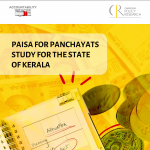
Functional Assignment: Some Thoughts on the Evolving Subject
19 October 2015
Early in September I attended a workshop on Functional Assignment (FA) led by subject matter experts – Rainer Rohdewohld and Gabrielle Ferrazzi. Organised by LOGIN, the workshop aimed at orienting practitioners of decentralisation in governance to the evolving discourse on FA. Bureaucrats, politicians, researchers and social activists from 10 Asian countries participated in the workshop making the sharing sessions quite rich and engaging. The workshop helped clarify concepts of FA and shed light on areas that are yet to be fully explored, as FA is a relatively new concept.
Simply put, “Functional Assignment” is the process of identifying and allocating responsibilities (Functions), personnel (Functionaries) and resources (Funds) to different tiers of government by applying principles of good management and decentralisation. Substantively, this means:
1. Undertaking a de jure and de facto assessment of institutional arrangements at all levels
2. Defining functional domains
3. Charting a blueprint or undertaking structural corrections (if malfunctioning systems are in place) to ensure that the 3 F’s are rationally assigned
Managing “change management”
At the heart of FA lies the idea that even if a higher tier of government assigns tasks to subnational governments, these subnational governments should have some say on the matter. That is, their agency/capacity to initiate programmes on their own and implement assigned tasks to further the cause of local development should be acknowledged in concrete terms. Thus in the context of FA, ‘devolution’[1] is viewed as the ideal mode for decentralizing. This idea appeared to make many of the participants (especially bureaucrats) uncomfortable, which led to some debate on the level of autonomy and capacity that should be awarded to subnational governments. This was a natural concern since most participants hailed from developing countries, each with their host of social, economic and political issues which made them hesitant about giving subnational governments (what appeared to be) a relatively free reign.
Two concerns appeared to be at the heart of the discomfort displayed during the workshop: First, the belief that subnational governments lack the capacity to perform complex tasks, resulting in an aversion to devolution. (To this Rainer responded by saying, “You can’t learn to swim without getting into the water!”), and second, the belief that FA would lead to a reduction in one’s responsibilities, access to resources and therefore power.
On this note, Rainer and Gabrielle introduced the idea of “change management” – a common concept in management parlance – and its importance when undertaking an exercise as massive as FA. They spoke of the need to have a steering committee that would chalk out a plan to ensure that the people working in the system are able to adapt to the changes in the smoothest possible manner. Since there is a general tendency to resist change, and hesitations about devolution are already clear, it might be worth assessing the way FA is pitched to a new audience/stakeholders that are likely to be a part of the FA process. One gets a clue about this when one looks at the existing literature on FA.
FA as a process is commonly described as an objective exercise in decentralisation while acknowledging the fact that devolving responsibilities “wholesale” may not be ideal since contexts vary. Other popular modes of administrative decentralisation such as ‘deconcentration’[2] or ‘delegation’[3] might be preferable in certain contexts. However, there is a visible bias in the literature towards ‘devolution’ as the ideal mode of decentralisation when carrying out the actual FA process. Perhaps if FA is pitched as a more neutral exercise that aims to rectify governance systems, the concept might become palatable to a wider audience.
What would be the implications of undertaking FA with devolution as the guiding principle in a context where deconcentration is more appropriate? In my next blog post, I will explore this point further and discuss some more thoughts around this subject.
(This is part 1 of 2 entries on Functional Assignment by the same author.)
[1] Some of the features of “devolved” governments are as follows: 1.The local government units are perceived as autonomous entities over which central authorities have little control; 2, they have clear and legally recognized geographical boundaries where they perform public functions; 3. Have corporate status and authority to raise their own resources. (UNDP, 1997)
[2] Deconcentrated governments display the following features: 1. The central administration has its regional/local offices in sub-state levels; 2. Involves limited transfer of authority. Jurisdictional authority of the central government reigns. (UNDP, 1997)
[3] Governments that adopt “delegation” as their preferred mode of decentralization display the following features: 1. They have semi-autonomous units such as urban or regional development corporations to whom aspects of governance are delegated through legislation or contract; 2. These units are not wholly controlled by the government but are legally accountable to the central administration. (UNDP, 1997)





